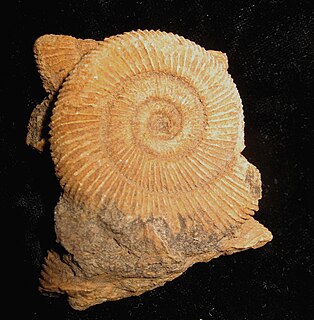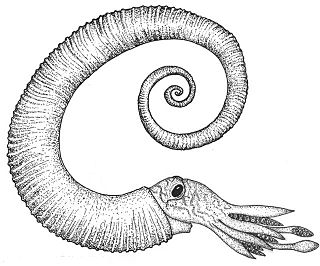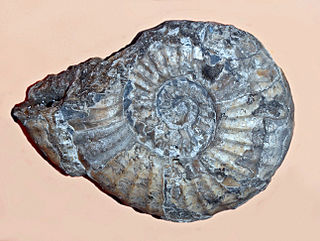
Ammonoids are a group of extinct marine mollusc animals in the subclass Ammonoidea of the class Cephalopoda. These molluscs, commonly referred to as ammonites, are more closely related to living coleoids than they are to shelled nautiloids such as the living Nautilus species. The earliest ammonites appear during the Devonian, and the last species vanished in the Cretaceous–Paleogene extinction event.

Dactylioceras was a widespread genus of ammonites from the Lower Jurassic period, approximately 180 million years ago (mya).

The Ancyloceratina were a diverse suborder of ammonite most closely related to the ammonites of order Lytoceratina. They evolved during the Late Jurassic but were not very common until the Cretaceous period, when they rapidly diversified and became one of the most distinctive components of Cretaceous marine faunas. They have been recorded from every continent and many are used as zonal or index fossils. The most distinctive feature of the majority of the Ancyloceratina is the tendency for most of them to have shells that are not regular spirals like most other ammonites. These irregularly-coiled ammonites are called heteromorph ammonites, in contrast to regularly coiled ammonites, which are called homomorph ammonites.

The body whorl is part of the morphology of the shell in those gastropod mollusks that possess a coiled shell. The term is also sometimes used in a similar way to describe the shell of a cephalopod mollusk.

A whorl is a single, complete 360° revolution or turn in the spiral growth of a mollusc shell. A spiral configuration of the shell is found in numerous gastropods, but it is also found in shelled cephalopods including Nautilus, Spirula and the large extinct subclass of cephalopods known as the ammonites.
Dorsetensia is a narrowly coiled discoidal ammonite from the early Middle Jurassic, lower Bajocian, belonging to the family Sonniniidae of the superfamily Hildoceratoidea. The inner whorls are ribbed or smooth, outer whorl is smooth. The outer rim (venter) is narrow, with a keel running along the middle. The umbilicus, the opening in the middle of the shell exposing inner whorls, is of moderate size with a sharp, sometimes undercut edge.

Placenticeras is a genus of ammonites from the Late Cretaceous. Its fossils have been found in Asia, Europe, North and South America.

Psiloceratoidea is a superfamily of Early Jurassic ammonoid cephalopods proposed by Hyatt in 1867, assigned to the order Ammonitida. They were very successful during Hettangian and Sinemurian. Last of them, family Cymbitidae and genera Hypoxynoticeras and Radstockiceras survived into Early Pliensbachian.
Neoptychites is an extinct ammonoid cephalopod genus from the Turonian stage of the Upper Cretaceous, with a worldwide distribution.

Oxynoticeratidae is a family of true ammonites included in the superfamily Psiloceratoidea.

Macrocephalites is a genus of the stephanoceratoid ammonite family Macrocephalitidae, diagnostic of the Callovian stage of the Middle Jurassic. Three subgenera, Dolikephalites, Kamptokephalites, and Pleurocephalites are recognized in addition to Macrocephalites itself, with Indocephalites tentatively included as the fourth.

Ancyloceratidae is a family of heteromorphic ammonites that lived during the Early Cretaceous. Their shells begin as a loose spiral with whorls not touching which then turns into a straight shaft that ends in a J-shape hook or bend at end. Coarse ribbing and spines are common.

Hauericeras is an ammonite genus from the Late Cretaceous that lived from the Coniacian to the late Maastrichtian, from about 90 to 66 mya. Fossils have been found in Europe, Russia, South Africa, Australia, India, Iraq, and in the United States.

Echioceratidae is an extinct family of ammonites that lived during Sinemurian stage of Early Jurassic.
Ovaticeras is an extinct genus of cephalopod belonging to the family Hildoceratidae. These cephalopods existed in the Jurassic period, during upper Pliensbachian and lower Toarcian. Its fossils were found in Europe, North Africa and possibly also in Canada and Vietnam. It might have evolved from Harpoceras falciferum and died out without leaving any descendants.

Cleviceras is an extinct genus of cephalopod belonging to the family Hildoceratidae. These cephalopods existed in the Jurassic period, during Toarcian and possibly even uppermost Pliensbachian age. Sometimes, it is considered to be a synonym of Eleganticeras.
Paracymbites is an extinct genus of lower Jurassic ammonite that lived during Raricostatum zone of upper Sinemurian. Animals belonging to this genus had small shells with semicircular whorl section and rounded or fastigate venter, of which umbilicus made about 25% of diameter. Last whorl could have been excentric. Keel was faint and it might have been only on the earlier part of the last whorl. Aperture had ventral rostrum. Body chamber made about 75% of whorl and was faintly plicate, or smooth.
Septimaniceras is genus of ammonites that has probably evolved from Peronoceras and lived during the middle Toarcian stage of early Jurassic. Members of this genus existed from Bifrons Subzone to lower part of Variabilis Subzone. Their fossils were found in France, Hungary and probably also in Austria.
Catacoeloceras is genus of ammonite that lived during middle to late Toarcian stage of early Jurassic. Members of this genus existed from Crassum Subzone of Bifrons Zone to Variabilis Zone. Their fossils were found in Europe, northern Africa, Asia, North America and South America. It has evolved from Peronoceras, or Porpoceras.
Nodicoeloceras is genus of ammonite that lived during early to middle Toarcian stage of early Jurassic. Members of this genus existed from Exaratum Subzone of Falciferum Zone to Commune subzone of Bifrons Zone. Their fossils were found in Europe, northern Africa, Asia, North America and South America. It has probably evolved from Dactylioceras (Orthodactylites) or Kedonoceras and gave rise to Mesodactylites.












